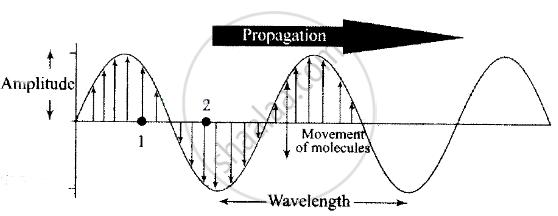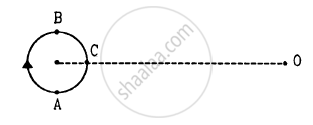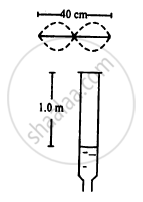Advertisements
Advertisements
प्रश्न
With propagation of longitudinal waves through a medium, the quantity transmitted is ______.
विकल्प
matter.
energy.
energy and matter.
energy, matter and momentum.
उत्तर
With propagation of longitudinal waves through a medium, the quantity transmitted is energy.
Explanation:
A wave is a disturbance which propagates energy and momentum from one place to the other without the transport of matter. The propagation of longitudinal waves through a medium leads to the transmission of energy through the medium without the matter being transmitted. There is no movement of matter (mass) and hence momentum.
Important point:
Characteristics of wave motion:
- It is a sort of disturbance which travels through a medium.
- Material medium is essential for the propagation of mechanical waves.
- When a wave motion passes through a medium, particles of the medium only vibrate simply harmonically about their mean position. They do leave their position and move with the disturbance.
- There is a continuous phase difference amongst successive particles of the medium, i.e. particle 2 starts vibrating slightly later than particle 1 and so on.

- The velocity of the particle during their vibration is different at different positions.
- The velocity of wave motion through a particular medium is constant. It depends only on die nature of the medium not on the frequency, wavelength or intensity,
- Energy is, propagated along with the wave motion without any net transport of the medium.
APPEARS IN
संबंधित प्रश्न
Two sound waves move in the same direction in the same medium. The pressure amplitudes of the waves are equal but the wavelength of the first wave is double the second. Let the average power transmitted across a cross section by the first wave be P1 and that by the second wave be P2. Then
A tuning fork of frequency 512 Hz is vibrated with a sonometer wire and 6 beats per second are heard. The beat frequency reduces if the tension in the string is slightly increased. The original frequency of vibration of the string is
A small source of sounds moves on a circle as shown in figure and an observer is sitting at O. Let \[v_1, v_2, v_3\] be the frequencies heard when the source is at A, B and C respectively.

A listener is at rest with respect to the source of sound. A wind starts blowing along the line joining the source and the observer. Which of the following quantities do not change?
(a) Frequency
(b) Velocity of sound
(c) Wavelength
(d) Time period
A steel tube of length 1.00 m is struck at one end. A person with his ear closed to the other end hears the sound of the blow twice, one travelling through the body of the tube and the other through the air in the tube. Find the time gap between the two hearings. Use the table in the text for speeds of sound in various substances.
The absolute temperature of air in a region linearly increases from T1 to T2 in a space of width d. Find the time taken by a sound wave to go through the region in terms of T1, T2, d and the speed v of sound at 273 K. Evaluate this time for T1 = 280 K, T2 = 310 K, d = 33 m and v = 330 m s−1.
The first overtone frequency of a closed organ pipe P1 is equal to the fundamental frequency of a open organ pipe P2. If the length of the pipe P1 is 30 cm, what will be the length of P2?
Consider the situation shown in the figure.The wire which has a mass of 4.00 g oscillates in its second harmonic and sets the air column in the tube into vibrations in its fundamental mode. Assuming that the speed of sound in air is 340 m s−1, find the tension in the wire.

A source of sound with adjustable frequency produces 2 beats per second with a tuning fork when its frequency is either 476 Hz of 480 Hz. What is the frequency of the tuning fork?
A boy riding on a bicycle going at 12 km h−1 towards a vertical wall whistles at his dog on the ground. If the frequency of the whistle is 1600 Hz and the speed of sound in air is 330 m s−1, find (a) the frequency of the whistle as received by the wall (b) the frequency of the reflected whistle as received by the boy.
